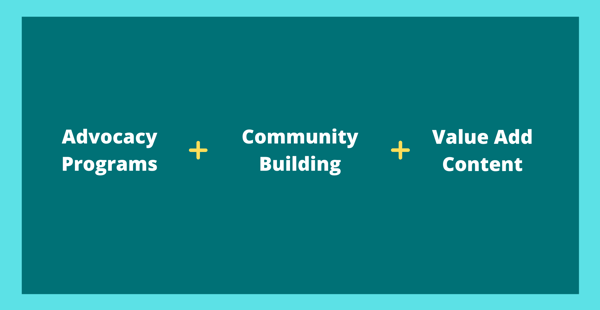Blog
How To Build Customer Loyalty & Retention | Post Purchase Experience
Customer loyalty and retention in eCommerce is becoming more difficult than ever. Customers are now much more fine-tuned to a brand’s user experience, as the abundance of choice in brands & retailers makes changing loyalties easy. One survey shows 61 percent of consumers are willing to switch brands for a better customer experience.
This article focusses on one of the most underutilised areas of the Customer Experience, a customer’s post-purchase experience. It is simply one of the greatest opportunities to invoke a sense of loyalty and keep customers coming back. When users experience an impeccable and engaging post-purchase experience -one that lasts well beyond the moment a person opens a package- they will be much more likely to repurchase. As well as that, they will also be more likely to engage in word-of-mouth activities that can attract more customers to your brand.
Beyond standard ideas like great user experience and being customer focused, we are going to provide cutting edge ideas that could revolutionise your brand. These strategies are much more oriented to customer loyalty and retention in the long-term.
Advocacy driven loyalty programs
While many brands have deployed traditional loyalty programs as part of their loyalty and retention strategies, these programs are becoming less effective at appealing to customers. It’s no longer enough to provide rewards for repurchasing behaviour—consumers crave interactions that go beyond simple one-way requests to purchase, giving them more choice in exactly how to support brands they love.
That is where the concept of advocacy-based loyalty comes in. Unlike the typical loyalty program, advocacy-based programs are systems that reward customers for a number of activities that go well beyond repurchasing products. Where standard loyalty programs reward transactions, advocacy-based programs reward customers for many different types of activity like posting content or coming up with product ideas.

Programs like this bring a deeper connection to the relationship between a brand and customer. Customers don’t feel that they are simply being encouraged to generate more revenue for the company, they are actively supporting a brand whose values and products they believe in, which in turn creates an emotional connection between the brand and customer. The importance of that emotional connection shouldn’t be understated. It is what makes a brand more memorable when a customer is considering repurchase, and it is something that competitors can’t easily replicate.
Advocacy based loyalty programs are highly customisable and will look different for every brand. At their core, all advocacy programs require brands to determine their target customer profile and then build a set of activities and incentives that drive customer behaviour.
To learn the essentials of building an advocacy program, read our guide here.
Community creation
Community marketing is an often misunderstood strategy that goes well beyond social media channels and event planning, and for many, it is an untapped source of lasting customer loyalty. Members of vibrant brand communities are loyal to other members within the group and encourage each other to support the brand.
Importantly, community members create interlinking relationships with each other, going beyond a reliance on the brand as the only source of culture and information. How does this help loyalty and retention? Firstly, it helps to develop authenticity. The idea is counter-intuitive, but community members will not always speak in a way that is inline with a brand’s messaging, and that can help brands address problems and speak candidly with customers. The members will trust each other and bond over shared experiences, and if brands manage this community well, they will only serve to build more trust.
Beyond authenticity, communities are groups that can grow organically and remain in constant communication. These groups can invite new members, share novel ideas and keep a steady flow of interaction going, and this ties into loyalty and retention because of the importance of relevance.
Communities are a vocal source of insight and feedback. Their input can be used to improve the customer experience across all touch points and build a more authentic understanding of the consumer base.
Personalised value-added content
The post-purchase phase of of the customer journey is full of opportunities for brands to provide more personalised value-added content. Many brands already include helpful content like tutorials or the option to buy accessories soon after purchase. While these are effective, the best way for brands to set themselves apart is to incorporate more personilisation. Individualised experiences stand out and make a customer feel special, and those feelings are tied to the memory of your brand and product. When they think of repurchasing, they’ll be pulling from the strong memory of your product’s emotional effects.
The core goal of all post-purchase content should be to address the needs of a customer. Data plays a crucial role in all of this. Brands should be tapping into the insights of all their customer-facing teams to recognize patterns of issues and needs that arise post purchase. The goal is to make customers feel like they are understood and taken care of, even after their transaction is complete.
These personalised touches can range in intensity as well. For some, it can be simply changing the colour of products to the preference of the customer based on previous purchase history. For others, it might be a simple e-mail thanking them for their continued support, or welcoming them to a new community if this is their first purchase.
In the eyes of a customer, the ideal post-purchase experience is one that answers all their questions and addresses all their issues before they arise.
Combine multiple strategies to maximize impact

Each of these mentioned strategies lead to authentic customer loyalty on their own, but the greatest impact comes from combining them. Brand communities can provide the platform to deploy a new advocacy program, and advocacy programs can gather valuable information that informs which type of value-added content will be most impactful for customers. There are many ways in which these strategies can be be mixed to get a result that is much greater than the sum of its parts.
The foundations of good post-purchase experience (and a major caveat)
There is plenty of potential for innovation and creativity in creating post-purchase experiences that drive loyalty and retain customers. Regardless of which new idea is being implemented, there are a number of key principles that all loyalty and retention efforts should adhere to.
Relevance & Timeliness
The post-purchase experience should always be relevant to the needs of the customer. The right solution, in the right place, at the right time. It may seem obvious, but it is tempting to leverage the post-purchase stage as another opportunity to sell more products. Sometimes that will be appropriate, but many times it will be misaligned with the goals of a customer.
Memorability
Memorability relates to difference between a customer’s experience and their expectations. Matching the incredibly high expectations of customers is simply not enough to be remembered. Brands need to exceed customer expectations to a degree that makes the experience memorable and delightful. Amazon’s tendency to deliver packages well before the delivery date is an excellent example of this.
Proactivity
Post-purchase strategies should be proactive, meaning they should anticipate the needs of a customer and serve them before they become an issue. Building proactivity into processes requires a excellent pattern recognition and market research.
Caveat: great CX and product promises are the baseline
Customer experience and product quality are the absolute foundation to loyalty and retention. If a product doesn’t live up to the promises it makes, or the customer experience is painful before a customer hits the post-purchase phase, it will be difficult for brands to convince them to come back.
Both the customer experience and product should address utility expectations (how the product performs) and affective expectations (how a product makes a person feel). Once these facets are fine-tuned, the post-purchase phase becomes a high-impact opportunity to drive customer loyalty and retention.
If you are looking for platforms or tools that can help with loyalty, retention and advocacy programs, read our buyer's guide.


